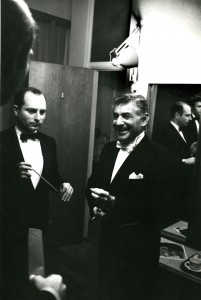by Sedgwick Clark
Mahler and Bruckner were once considered the Tweedle Dum and Tweedle Dee of composers. Today, Mahler cycles are a dime a dozen, but Bruckner remains a harder sell. Critics snickered when Cleveland Orchestra Music Director Franz Welser-Möst maintained at a press conference last year that Bruckner was the musical granddaddy of John Adams and minimalism in general. As it turned out, the two composers made surprisingly simpatico concert partners at Lincoln Center Festival’s “Bruckner: (R)evolution” with the Cleveland two weeks ago. Adams stated in the program book that “Bruckner, from a very early age, spoke to me.” And despite Fisher Hall’s empty balcony, the wild standing ovations made one wonder if Bruckner’s time has come at last.
Some moments of stridency aside, the Clevelanders sounded gorgeous in Fisher, where they haven’t played for some 30 years. Lincoln Center execs and a few audience members floated the notion at intermission that perhaps the hall didn’t need altering after all. (Dream on, friends.) Word was that W-M liked the hall and felt that one need only hold back the brass and battery a smidgen. Sorry, gang, that only resulted in muffled timpani and tentative brass attacks here and there in the Bruckners; textures in the Adams works, on the other hand, were transparent as could be.
The lightweight, hasty Bruckner recordings made by W-M several years ago for EMI, were happily effaced by these solidly traditional readings. Especially welcome was his cogent sense of structure in music that easily descends into stop-and-go patchwork. Many conductors further sectionalize the works by inserting unmarked cadential ritards. W-M also, more than most, gave full value to the composer’s famed pauses. Rarely have Bruckner symphonies seemed so logical.
That said, rarely has Bruckner seemed so poker-faced. One prayed in vain for a slight expansion of the phrase, but the deeply emotional, spiritual depth of the music had to be recollected from other performances. W-M’s dutiful conducting of the Fifth Symphony on opening night (7/13) was short on character, expressiveness, and, believe it or not, playfulness. The droll tango-like dance at rehearsal letter F in the first movement, the impetuous Scherzo, and the perky solo clarinet statement of the fugue motive in the finale, were hopelessly flatfooted. Yes, Bruckner skeptics, the composer actually had a sense of humor! (So did the Minnesota Orchestra, according to the orchestra’s long-time observer Dennis Rooney, whose members so detested their conductor’s interpretation of the Fifth that they made up a rude lyric to the fugue subject, below: “F–k you, Skrowacewski, you can shove it up your ass right now!”)

Once one accepted W-M’s interpretive approach — more akin to Beethoven than to Wagner — the subsequent Seventh, Eighth, and Ninth were more easily appreciated, even if one recalled more moving performances in the past. Indeed, apart from a less-than-demonic Scherzo, W-M’s Ninth was quite impressive. Such details as his well-judged tenuto in the first movement to allow the solo clarinet in letters G and V to make its poetic point and the lambent loveliness of the forte strings at L in the finale demonstrated an eminently sensitive Brucknerian.
For me, the Eighth Symphony (7/16) was the high point of W-M’s Bruckner performances. He elected to perform its original 1887 version and has declared it to be “the best view of Bruckner’s true vision for this symphony,” according to Cleveland Orchestra program annotator Eric Sellen. Other than scholars and critics, however, I’d be surprised if many audience members were even aware or cared about which version was used.
Briefly, Bruckner had a lot of second thoughts about his music. According to the British musicologist Deryck Cooke in his c. 1970 essay, “The Bruckner Problem Simplified,” no less than 34 different scores for the nine symphonies exist in the composer’s own hand and those of others. Only the Fifth (which was never performed in his lifetime) and Sixth (of which only the second and third movements were performed in his lifetime) are free of such intervention. Compounding The Bruckner Problem, an article in the Times on July 10 by Benjamin Korstvedt debunks the long-reigning British Bruckner scholars led by Cooke and Robert Simpson, and by extension American critics who have followed them in lockstep. His book on the Eighth in the superb Cambridge Music Handbooks series is necessary reading for all Brucknerites.
There are two modern editions of the Eighth, by Robert Haas and Leopold Nowak, both based on Bruckner’s 1890 revision. The controversial Haas reinstates 50 bars from the 1887 original, which to my ears provides smoother transitions and breadth, but scholars and many conductors reject it. Hearing the Eighth in the original 1887 version after years of acquaintance with these two editions is positively surreal. While the music’s basic thrust was the same in 1887, continuity suffers throughout due to inferior voice leading and orchestration; the quiet ending of the revision is incomparably superior to the grotesque 30 bars of fortissimo in 1887; the Scherzo is substantially different, with a quite inferior Trio; repetitions continue to sometimes laughable lengths; the elongated climax of the third movement is far less focused and effective; the fortissimo of the last-movement coda is jarringly interrupted by fussy changes in dynamics. That W-M could seriously prefer the 1887 version over Bruckner’s 1890 revision or Haas’s expert conflation of the two is hard to believe. But we can thank him for his clear, musicianly performance — far superior to the Inbal and Tintner recordings of the original — because it settled forever in my mind that Bruckner’s first thoughts were drastically in need of revision.
And what about John Adams?
I confess I haven’t always found myself in agreement with my colleagues’ praise. Of the old Glass-Reich-Adams trio of minimalists, Adams has moved the most into the mainstream. I can’t help being distracted when a composer’s influences are so apparent, even if the strongest is Stravinsky. The attractive 20-minute Guide to Strange Places (2001), on the opening concert, bustled innocently at the beginning like Petrushka’s Shrovetide Fair before settling into less comfortable resonances of Copland’s dissonant Organ Symphony.
Leila Josefowicz seemed an ideal soloist in the composer’s Violin Concerto (1993), but after three hearings of the piece I despair of ever agreeing with its champions. Its whiffs of Szymanowski, Prokofiev, and Barber in the outer movements are never as distinctive as the originals, and the slow Chaconne was both shapeless and faceless. Just what is Adams’s voice, anyway? Curiously, the end of the last-movement Toccare petered out with a most ineffectual thud. Sure couldn’t say that of the Bruckner Seventh, which followed.
To my astonishment, I was blown away by Adams’s Doctor Atomic Symphony. Okay, like the opera, it opens with one of his cheekiest ripoffs: Carl Ruggles’s Sun Treader. But it works — boy, does it work! I had heard the world premiere with the BBC Symphony, conducted by the composer at London’s Proms in 2007; at 40 meandering minutes, it was not ready for prime time. The next year I saw the Met production and subsequent PBS broadcast of the complete opera and couldn’t hack more than an act of either. At some point, Adams slashed 15 minutes from the Symphony version. Thus tightened to 25 minutes (the same length as that other powerhouse symphony-from-an-opera, Hindemith’s Mathis der Maler) and liberated from Peter Sellars’s unsingable, unintelligible libretto, one was able to concentrate on Adams’s music for the first time. David Robertson led a fine performance at Carnegie with the Saint Louis Symphony and recorded it for Nonesuch, paired with Guide to Strange Places. Who would have thought that Franz Welser-Möst would efface them all with a performance of humbling emotional commitment and a trumpet soloist, Michael Sachs, singing the vocal line of Oppenheimer’s first-act aria with surpassing beauty? Doctor Atomic Symphony was the revelation of LC’s Bruckner: (R)evolution.
Adams was present for each performance, smiling broadly. Who wouldn’t be thrilled hearing his music conducted with such care and played with such orchestral sheen? As to whether he is a musical descendent of Bruckner, the jury remains out.
As Time Goes By
America’s favorite Hollywood classic, Casablanca, will be shown at Saratoga tonight (Thursday, 7/28) with the Philadelphia Orchestra playing the immortal Max Steiner’s music and encored at Wolf Trap, down D.C. way, on Saturday, 7/30, with the National Symphony. On September 8 and 9 the New York Philharmonic under David Newman (grandson of noted Hollywood composer Alfred Newman) will play Leonard Bernstein’s greatest hit, West Side Story, as the film is projected at Avery Fisher Hall.
This merging of superb film music and live orchestra performance was the inspired brainchild, some 20 years ago, of Lincoln Center’s master of video (Live from Lincoln Center), John Goberman. His initial venture was Prokofiev’s Alexander Nevsky, perhaps the best film score ever written and almost certainly the worst recorded one. He’s done The Wizard of Oz (why not in New York?!!), Hitchcock’s Psycho on Halloween, scenes from R&H musicals, etcetera, etcetera, etcetera.
So, John, how about The Big Country, North by Northwest, King Kong, The Magnificent Seven, The Adventures of Robin Hood, Lawrence of Arabia, Ben-Hur, and How the West Was Won . . . and, of course, Gone With the Wind?
Name your tune!
Looking Forward
My week’s scheduled concerts:
7/28 Alice Tully Hall. Royal Danish Orchestra/Michael Schønwandt. Nielsen: Pan and Syrinx; Clarinet Concerto. Stravinsky: Pulcinella.

